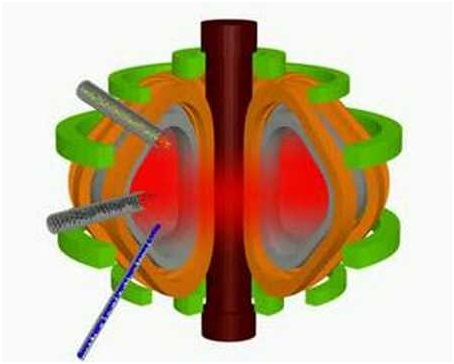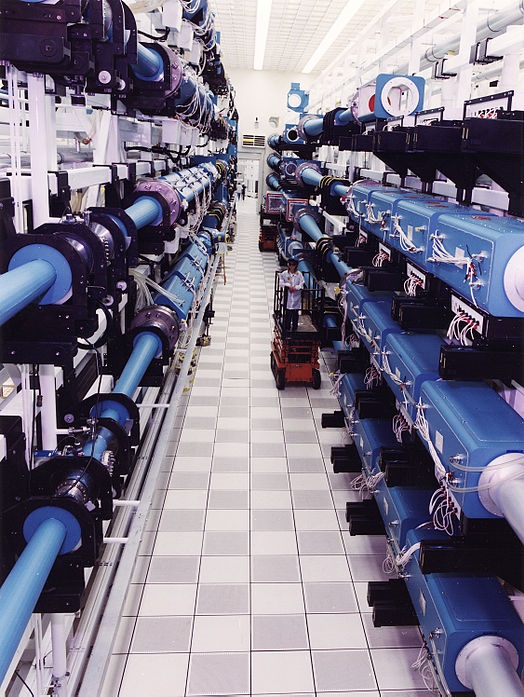
Blog
-
Geiger Readings for January 14, 2013
Ambient office = 76 nanosieverts per hourAmbient outside = 81 nanosieverts per hourSoil exposed to rain water = 88 nanosieverts per hourIceberg lettuce from Top Foods = 106 nanosieverts per hourTap water = 65 nanosieverts per hourFiltered water = 60 nanosieverts per hour -
Nuclear Fusion 8 – History 6
In 1991, Small Tight Aspect Ratio Tokamak (START) experiment was started at Culham, a village near Abingdon in Oxfordshire, U.K. One of the innovations of START was to shrink the aspect ratio of the reactor from the older race track tokamak design to a more spherical shape. It ultimately achieved a record ratio of plasma pressure to magnetic field pressure of forty percent (this ratio is called the beta of the reactor). START utilized a neutral beam injector. This approach consists of injecting a stream of neutral atoms (deuterium in START) into the center of the plasma to assist in heating it.
In 1992, the Engineering Design Activity for the International Thermonuclear Experimental Reactor began following the Conceptual Design Activity for the International Thermonuclear Experimental Reactor which had started in 1988. Euratom, Japan, Russia and the United States are involved in the ITER project.
In 1993, the Experimental Tokamak Fusion Test Reactor (TFTR) at Princeton Plasma Physics Laboratory in New Jersey began testing a mixture of fifty percent deuterium and fifty percent tritium. Later, the TFTR managed to produce ten megawatts from a controlled fusion reaction. It was hoped that the TFTR would ultimately be able to reach the break-even point where more energy was produced than was consume but it was never able to reach break-even.
In 1994, the National Ignition Facility at the Lawrence Livermore National Laboratory completes work on the Beamlet laser which was started in 1990. This laser was designed and constructed to act as a test bed for the development of lasers for fusion research. A comprehensive study of Heavy Ion Fusion called the Heavy Ion Driven Inertial Fusion Study is undertaken in Europe at the Gesellshaft für Schwerionenforschung. The project includes work in fourteen laboratories including labs in the U.S. and Russia.
In 1996, the French Tora Supra tokamak achieves a record two minutes plasma confinement. This included about one million amperes of induced current driven by lower hybrid frequency waves. Active cooling the components that faced the plasma in the tokamak made this possible and helped pave the way for the active control of steady state plasma discharges.
In 1997, the Joint European Torus in the UK generates sixteen megawatts of power from fusion processes which represented a world record for power generation from fusion. The Lawrence Livermore National Laboratory conducts a study of the projected costs of different fusion sources in an attempt to estimate future energy generation costs. They concluded that Heavy Ion Fusion reactors should cost more than a natural gas generator but less than a new fission reactor. A ceremony is held for ground-breaking for the National Ignition Facility (NIF) at the Lawrence Livermore National Laboratory. The NIF is the biggest and most powerful inertial confinement fusion device ever built. Powerful lasers heat and compress a tiny hydrogen pellet to ignite a fusion reaction. A new fusion concept called Magnetized Target Fusion is explored in the U.S. A field-reversed pinch is combined with an imploding magnetic cylinder in this approach. A low density plasma device is compressed explosively with techniques developed for high-speed gun research.
START design for a tokamak:
-
Geiger Readings for January 13, 2013
Ambient office = 98 nanosieverts per hourAmbient outside = 134 nanosieverts per hourSoil exposed to rain water = 124 nanosieverts per hourRoyal rivera pear from Top Foods = 99 nanosieverts per hourTap water = 85 nanosieverts per hourFiltered water = 69 nanosieverts per hour -
Geiger Readings for January 12, 2013
Ambient office = 87 nanosieverts per hourAmbient outside = 155 nanosieverts per hourSoil exposed to rain water = 178 nanosieverts per hourHass avacado from Top Foods = 91 nanosieverts per hourTap water = 106 nanosieverts per hourFiltered water = 89 nanosieverts per hour -
Radiation News Roundup January 11, 2013
More than a decade and a half after the Cold War ended, the world’s combined stockpile of nuclear warheads remain at unacceptably high levels. ploughshares.org
A freezing valve resulted in a water spill on the grounds of Entergy’s River Bend nuclear plant Tuesday, but it did not pose a risk to public health. nuclearstreet.com
-
Geiger Readings for January 11, 2013
Ambient office = 118 nanosieverts per hourAmbient outside = 110 nanosieverts per hourSoil exposed to rain water = 113 nanosieverts per hourRedleaf lettuce from Top Foods = 110 nanosieverts per hourTap water = 78 nanosieverts per hourFiltered water = 65 nanosieverts per hourAlaskan Copper River Salmon = 88 nanosieverts per hour -
Nuclear Fusion 7 – History 5
In 1979, the U.S. Los Alamos National Laboratory demonstrated the radio frequency quadrupole accelerator (RFQ). The RFQ is a linear accelerator with low beam energies between fifty thousand electron volts and three million electron volts which accelerates and focuses a stream of charged particles. The U.S. Argonne National Laboratory and Hughes Research Laboratories demonstrate an ion source utilizing a xenon beam at one and one half million electron volts. A report to the U.S. DOE concluded that Heavy Ion Fusion (HIF) was the best path to commercial fusion power reactors. The Director of the DOE Department decides to invest more effort and resources in HIF.
In 1982, German and U.S. researchers work on a Conceptual Heavy Ion Beam Driven Fusion Reactor (HIBALL) design. The design includes four chambers served by a single radio frequency accelerator and liquid lithium inside the walls of the chambers. The French begin construction of a tokamak design they call “Tore Supra.” The name is derived from torus and superconducting. Their design is the first tokamak that utilizes superconducting magnets to generate a powerful permanent poloidal field.
In 1983, the Joint European Torus is completed in the U.K. after almost ten years of work and first plasma tests are conducted. At the Lawrence Livermore National Laboratory, the NOVETTE laser begin operating. It is used to test design concepts for the next generation of Inertial Confinement Fusion lasers. NOVETTE is a two beam neodymium laser that was constructed from parts of the Shiva and Argus lasers.
In 1984, Lawrence Livermore National Laboratory finishes construction of the big ten beam NOVA laser utilizing information from the NOVETTE laser. NOVA was the first inertial confinement fusion experiment which was intended to reach “ignition.” Ignition is a nuclear fusion chain reaction that releases a large amount of energy. NOVA failed to reach ignition but its failure highlighted the problem of magnetohydrodynamic instability in the plasma. NOVA laid the groundwork for future fusion reactor designs.
In 1985, the U.S. National Academy of Sciences surveyed all the U.S. military research programs for inertial confinement fusion. The survey mentioned that Heavy Ion Fusion (HIF) did have a lot of advantages. There was concern that the military program were heavily reliant on civilian research programs. The survey conclusion was that the primary purpose of HIF research should be for commercial power generation. In the same year, Japan completed their Japan Torus-60 (JT-60) tokamak and conducted plasma experiments. This reactor is still in use today and has produced important findings for fusion research.
In 1988, the Soviets completed their T-15 tokamak which included helium cooled superconducting coils for generating the magnetic fields. The Conceptual Design Activity for the International Thermonuclear Experimental Reactor (ITER) project began in 1988. It would follow and build on the knowledge gained by the T-15, TFTR, JET and JT-60 tokamaks. Euratom, Japan, the U.S.S.R. and the U.S. were all participants in the project which concluded in 1990.
Laser bay of the NOVA laser at Lawrence Livermore National Laboratory:
-
Radiation News Roundup January 10, 2013
Fukishima fall-out fears increase as DOUBLE the normal amount of radiation is found in Missouri snow and San Francisco beach busts radiation safety levels. dailymail.co.uk
The Japanese Nuclear Regulatory Agency demanded that TEPCO drop test waste canisters to be used to hold highly radioactive sludge from the Advanced Liquid Processing System being used to decontaminate water at Fukushima. fukuleaks.org
Early nuclear safety posters are perky and disturbing. io0.com
The Lungmen nuclear power plant could be in operation by the end of this year or early next year, according to reported statements from Taiwanese planners. world-nuclear-news.org





